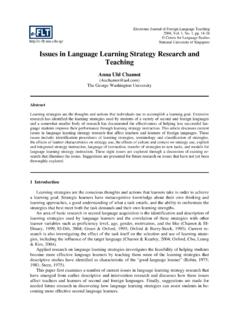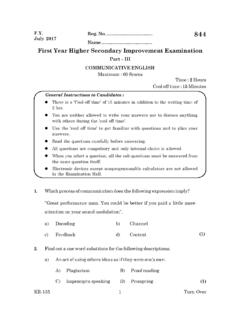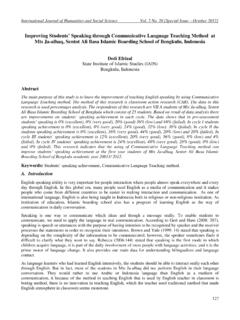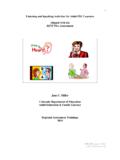Transcription of The Role of Grammar in Communicative Language …
1 Electronic Journal of Foreign Language teaching 2012, Vol. 9, No. 1, pp. 61 75 Centre for Language Studies National University of Singapore The Role of Grammar in Communicative Language teaching : An Exploration of Second Language Teachers Perceptions and Classroom Practices Cathy Chiu Yin Wong Monmouth University, USA Mirta Barrea-Marlys Monmouth University, USA Abstract The purpose of the present qualitative case study was to look into second Language (L2) teachers perceptions and classroom implementations of Grammar instruction with regard to Communicative Language teaching (CLT). The study focused on individual teachers perspectives of CLT because teachers perceptions of their pedagogical skills have an impact on how they teach (Bandura, 1993, 1997). Participants were six college level teachers who taught Spanish as L2 in a major university in the Southern United States.
2 Data were collected through classroom observations, interviews, and document and record collection. The findings indicated that there was a mixture of perceptions regarding the inclusion of explicit Grammar instruction in a CLT classroom. The findings also re-vealed that teachers perceptions of what they deem to be effective L2 instruction are influenced by their experi-ence as learners as well as their observation of student learning. The results suggest that teachers beliefs are gen-erally reflected in their classroom practices, but exceptions may occur due to departmental regulations. Pedagogi-cal implications for teacher education and world Language methods courses were drawn up based on the findings of the study. 1 Introduction The idea of Communicative Language teaching (CLT) has been expanded since the mid 1970s.
3 CLT was also greatly influenced by the early version of Long s (1983a, 1983b, 1996) Interaction Hypothe-sis. Since then, second Language (L2) instructors have been encouraged to employ Communicative ways of teaching in their classrooms. The focal point of CLT was almost exclusively on meaningful interaction through the use of spontaneous speech during pair and/or group work. There are various methods for teaching communicatively, for example, immersion, task-based instruction, structured input, and The Natural Approach (Krashen & Terrell, 1983). One controversial aspect of CLT is the role of Grammar instruction. Krashen s (1982, 1985) Monitor Theory suggests that Grammar instruc-tion is unnecessary and has a very minimal effect on second Language acquisition (SLA).
4 Since the revised version of the Interaction Hypothesis (Long, 1996), CLT scholars have become interested in integrating form-focused instruction with Communicative activities (Spada & Lightbown, 2009). Pica (2000) argues that Communicative teaching that focuses mainly on meaning with very little attention Cathy Chiu Yin Wong and Mirta Barrea-Marlys 62 to forms are not adequate to prepare learners for attaining native-like proficiency. As such, the role of Grammar in CLT needs to be justified. Instructors pedagogical practices and their decisions regarding teaching methods are heavily influenced by their teacher beliefs. This study aims at examining the perceptions of Grammar instruction of six college level teachers who teach Spanish as L2 and at ex-ploring how they implement Grammar instruction in their CLT classrooms.
5 2 Background of the study Communicative Language teaching and Communicative competence The fundamental goal of CLT is to develop learners Communicative competence in L2 through communication and interaction with others (Brown, 2002; Canale & Swain, 1980; Mochida, 2002). An important aspect of Communicative competence is related to effectiveness and appropriateness of speech during the process of communication, as described by Rickheit and Strohner (2008). They state that whereas effectiveness describes the outcome of Communicative competence, appropriateness connects it with the situational conditions of the actual social interaction (Rickheit & Strohner, 2008, p. 16). The term Communicative competence was first used by Hymes (1972, 1974) to refer to a speakers capability to speak a Language with linguistic proficiency and to use Language appropriately in differ-ent social contexts.
6 Savignon (1972) describes Communicative competence as the ability to function in a truly Communicative setting that allows learners to communicate with other speakers effectively and spontaneously. Savignon (1976) further explains that Communicative competence is dependent on the negotiation of meaning between speakers, because communication is spontaneous. Speakers need to negotiate meaning based on what is unclear to them. To achieve Communicative competence, learners need to be competent in four aspects: linguistic, sociolinguistic, discourse, and strategic competence (Canale, 1983; Canale & Swain, 1980; Swain, 1985). According to Canale (1983) and Canale and Swain (1980), linguistic competence, which is also called grammatical competence, concerns learners use of lexis, syntax, and structures.
7 Sociolinguistic competence concerns learners appropriate use of Language in different situations and settings. Dis-course competence refers to the speakers ability to form oral and written Language appropriately and meaningfully. As suggested by the term itself, strategic competence relates to the use of strategies that can be used to make up for the inadequate abilities in other aspects of competence. Researchers have investigated the acquisition of each competence (see Meyer, 1990; Rintell, 1990; Sato, 1990; Swain & Lapkin, 1990). These studies provide evidence that each competence plays a significant role in the acquisition of Communicative competence. However, teachers seem to deem-phasize Grammar accuracy in their CLT classrooms (Wang, 2009). According to Savignon (2002), there is a difference between Communicative competence and Communicative ability.
8 Communicative competence refers to the ability to interpret information, express oneself, and negotiate meaning. Communicative ability refers to the ability to comprehend meaning and to use forms appropriately. This implies the importance of Grammar learning in order to achieve a higher level of communication. In the context of CLT, whether or not Grammar instruction should be included has been a controversial topic. The role of Grammar in Communicative Language teaching There is a mixture of beliefs regarding Grammar instruction. Some scholars support the exclusion of Grammar learning ( Prabhu, 1987), while other researchers emphasize the need to include Grammar teaching in CLT ( Lightbown & Spada, 1990; Nassaji, 2000; Spada & Lightbown, 1993). Krashen s (1982, 1985) hypothesis of acquisition versus learning has had an influence on the notion that focusing solely on meaning is sufficient for SLA.
9 In his hypothesis, Krashen claims that there is a distinction between acquisition and learning. He believes that acquisition happens naturally, provided The Role of Grammar in Communicative Language teaching 63 that learners receive sufficient comprehensible input, and that only acquired knowledge can lead to fluent communication. Also, Krashen s Monitor Hypothesis proposes that explicit form teaching only serves as a tool for monitoring learners Language . That is, learners learn grammatical rules only to monitor the correctness of their Language use, which is in addition to what has been acquired. How-ever, the advocates of explicit Grammar instruction argue that it is inadequate to acquire a L2, if mean-ing is the only focus. Long (1991) differentiates between focus on forms and focus on form.
10 He defines focus on forms as learning Grammar rules, and focus on form as drawing learners attention to Grammar in activities and tasks. In the past two decades, some researchers have returned to the investigation of form-focused instruction in CLT ( Celce-Murcia, 1991; Doughty & Williams, 1998; Ellis, 1993; Long & Crookes, 1992). The studies on Language accuracy of students in an immersion program in Canada provide important evidence that form focused instruction is needed ( Harley & Swain, 1984; Swain, 1985). These immersion students received massive amounts of input and had plenty of interaction in the program for a period of time, but their utterances still contained grammatical mistakes. As a result of excluding form-focused instruction, the learners output lacked in accuracy (Williams, 1995).













